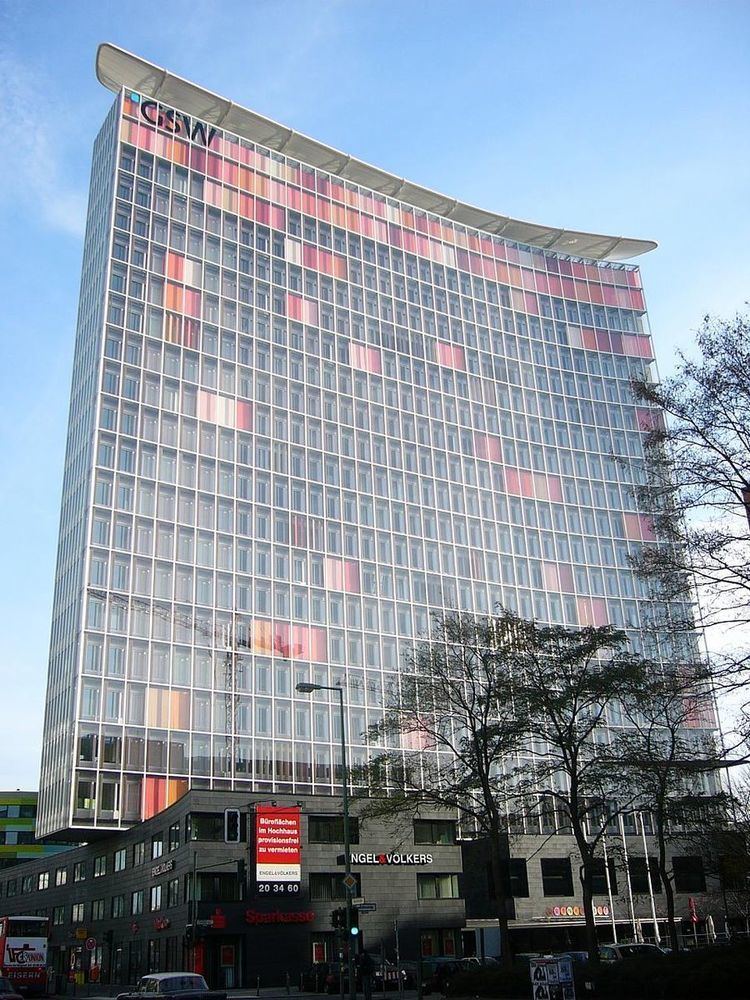 | ||
Sauerbruch hutton m9 museum english
Sauerbruch Hutton is an architecture practice based in Berlin, Germany. It was founded by Matthias Sauerbruch and Louisa Hutton in 1989. The firm creates functional, sensual and conscientious architecture with individuality and personality. The practice is noted for its synthesis of colour in the design process, and for the use of fluid curvilinear forms. The firm’s architecture is also known for its technical innovation and environmental sustainability, particularly double-skin facades on tall buildings, with the GSW Headquarters in Berlin (1991) and KfW Westarkade (2010) in Frankfurt as examples.
Contents
- Sauerbruch hutton m9 museum english
- New forum obernai architects sauerbruch hutton
- Biography
- Early work
- The GSW Headquarters
- Recent works
- Recognition
- Projects
- References
The practice is led by Matthias Sauerbruch, Louisa Hutton and Juan Lucas Young.
New forum obernai architects sauerbruch hutton
Biography
Matthias Sauerbruch (b. 1955) studied architecture at Berlin’s Hochschule der Künste (now Berlin University of the Arts) and at the Architectural Association in London, graduating in 1984. He has worked at Rem Koolhaas’s Office for Metropolitan Architecture in London, leading the House at Checkpoint Charlie project. He has maintained an involvement in teaching throughout his professional career, having held professorships at the University of Virginia, the State Academy of Art and Design in Stuttgart and Berlin Technical University. In 2005 he was appointed Kenzo Tange Visiting Design Critic at the Harvard Graduate School of Design. From 2012 to 2015 he was a guest professor at Berlin University of Arts Universität der Künste. He's a commissioner of the Zurich Building Council, a trustee of the Bauhaus Dessau Foundation and a Honorary Fellow of the American Institute of Architects. A member of the Academy of Arts, Berlin, in 2013 he was the curator of “Culture:City” [1], an exhibition shown at the Academy of Arts, Berlin and at Kunsthaus Graz that took a critical eye to the relationship between culture, architecture and urban development. Sauerbruch is a grandson of the surgeon Ferdinand Sauerbruch.
Louisa Hutton (b. 1957) completed her undergraduate degree at Bristol University and later graduated from the Architectural Association. She worked at the offices of Alison and Peter Smithson and has taught at the AA, the University of Virginia and Harvard University. She is a member of the Curatorial Board of the Schelling Architekturstiftung, and was a Commissioner at CABE and a member of the first Steering Committee for the Bundesstiftung Baukultur. In 2014 Louisa Hutton was elected as a Royal Academician of the Royal Academy of Arts.
Early work
The firm’s first offices were located in London, where both founders were engaged in teaching roles. Many of their first commissions were in relatively confined urban areas, such as L House in London. A typical Victorian terrace, this was the practice’s first essay in applied colour. The architects used colour to visually expand the cramped spaces.
Early competition entries for Paternoster Square in London (1989), Tokyo International Forum (1989) and the Junction Building in Birmingham (1989) all offered socio-culturally and environmentally sustainable alternatives to the conventions in architecture and planning at the time.
The GSW Headquarters
The GSW Headquarters is situated 250 meters from Checkpoint Charlie. It was the first tall building to rise in Berlin after the fall of the Berlin Wall. The winning competition proposal by Sauerbruch Hutton was a critique of the "Critical reconstruction" established by Hans Stimmann, Berlin's building director from 1991 to 2006.
The GSW Headquarters has double-skinned facades. The system of blinds on the west facade plays an important role in controlling solar gains and reduces the use of artificial heating and cooling. Polychromy was a key feature of the blinds.
Recent works
Their work for GSW gained Sauerbruch Hutton considerable renown and established their worldwide reputation. In the works that followed, they continued to develop their expertise on sustainable building solutions as well as the use of colour as a building material on projects throughout Europe. The Federal Environmental Agency in Dessau (2005) was a benchmark in the design of sustainable office buildings.[2] The colour scheme of the facade picking colours from its surroundings helps root the massive scheme. A serpentine plan fosters a personal, corporeal perception of the building as one walks along its length – an uncommonly sensuous gesture for an office building.
An inventive spirit pervades all of the practice’s work, resulting in a portfolio of prototypical and thoroughly original architecture. Printed glass emerged as one of the practice’s research interests, with their Pharmacological Research Laboratories (2002) and Jessop West (2008) and Cologne Oval Offices testing new potential for the material. In 2008, with the Brandhorst Museum, Sauerbruch Hutton also began exploring the applications of glazed ceramic as a facade material which is being continued in the development of the M9 Museum in Mestre/Venice.
In the last decade the practice has worked outside of Germany on projects in the UK, Finland, France, Italy, Switzerland and Luxembourg.
Recognition
The firm's GSW Headquarters won the Berliner Architekturpreis and Deutscher Architekturpreis, as well as several RIBA and AIA Awards and was nominated for a Stirling Prize in 2000. Several projects have been nominated for or reached the shortlist of the Mies Van Der Rohe Award. The Sitra Headquarters project received a 2011 Holcim Awards for Sustainable Construction [3] and the KfW Westarkade received the 2011 Best Tall Building Worldwide Award. [4].
In acknowledgement of their built works Sauerbruch Hutton were awarded the Erich Schelling Prize for Architecture in 1998., the Fritz Schumacher Prize for Architecture in 2003, the International Honour Award for Sustainable Architecture in 2010 and the Gottfried Semper Architekturpreis in 2013.[5]
